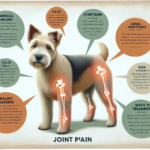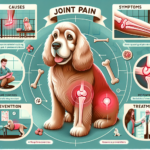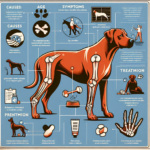Glen of Imaal Terrier Joint Pain: Causes, Symptoms, Prevention, and Treatment

Introduction
The Glen of Imaal Terrier, affectionately known as the “Glen,” is a small but sturdy breed originating from the Glen of Imaal in County Wicklow, Ireland. Historically bred for hunting and eradicating vermin, these terriers are known for their tenacity, intelligence, and affectionate nature. With a distinctive appearance characterized by a broad head, strong jaw, and a wiry coat, the Glen of Imaal Terrier is a unique and charming breed.
Like many purebred dogs, Glens are prone to certain health issues, including joint pain. Joint health is particularly crucial for this breed due to their active lifestyle and genetic predispositions. Understanding the causes, symptoms, prevention, and treatment of joint pain in Glen of Imaal Terriers can help owners ensure their pets lead healthy, comfortable lives.
Breed-Specific Joint Pain Risks
Genetic Predisposition
Glen of Imaal Terriers are genetically predisposed to several joint-related issues, including hip dysplasia, elbow dysplasia, and arthritis. Hip dysplasia, a condition where the hip joint doesn’t fit properly into the hip socket, is particularly common. This genetic predisposition can lead to joint pain and mobility issues, making it essential for breeders to screen for these conditions.
Age-Related Risks
As Glen of Imaal Terriers age, the risk of developing joint pain increases. Older dogs are more susceptible to arthritis, a degenerative joint disease that causes inflammation and pain. Owners should be vigilant about monitoring their dogs for signs of joint pain as they reach middle age, typically around 5-7 years old.
Activity Level and Joint Stress
Glen of Imaal Terriers are known for their high energy levels and love for physical activities such as running, jumping, and playing. While regular exercise is essential for their overall health, excessive or high-impact activities can put stress on their joints, potentially leading to joint pain. Owners should balance their dogs’ activity levels to prevent undue stress on their joints.
Common Symptoms of Joint Pain in Glen of Imaal Terriers
General Symptoms
Owners should watch for common symptoms of joint pain, including:
- Limping: A noticeable limp or favoring one leg over another.
- Stiffness: Difficulty moving, especially after resting or sleeping.
- Reluctance to Move: Hesitation or refusal to jump, climb stairs, or engage in physical activities.
- Swelling: Visible swelling around the joints.
- Whining or Crying: Vocalizing pain when moving or being touched.
Breed-Specific Symptoms
In Glen of Imaal Terriers, joint pain may manifest in specific ways, such as a reluctance to engage in their usual playful behavior or a noticeable decrease in their activity levels. Owners may also observe changes in their dogs’ gait or posture, indicating discomfort.
When to Consult a Vet
If any of the above symptoms are observed, it is crucial to consult a veterinarian promptly. Early diagnosis and intervention can significantly improve the quality of life for a dog suffering from joint pain. Regular veterinary check-ups are also essential for monitoring joint health and catching any issues early.
Preventive Measures for Joint Health
Exercise Recommendations
Regular, moderate exercise is vital for maintaining joint health in Glen of Imaal Terriers. Activities such as walking, swimming, and gentle play can help keep their joints flexible and muscles strong without causing excessive stress. Avoid high-impact activities like jumping or running on hard surfaces, which can exacerbate joint issues.
Dietary Suggestions
A balanced diet rich in essential nutrients can support joint health. Consider incorporating foods or supplements that contain:
- Glucosamine and Chondroitin: These supplements can help maintain cartilage health and reduce inflammation.
- Omega-3 Fatty Acids: Found in fish oil, these fatty acids have anti-inflammatory properties that can benefit joint health.
- Antioxidants: Vitamins C and E can help reduce oxidative stress and inflammation in the joints.
Weight Management
Maintaining a healthy weight is crucial for reducing joint stress. Overweight dogs are more likely to develop joint pain due to the extra pressure on their joints. Owners should monitor their dogs’ weight and adjust their diet and exercise routine as needed to keep them at an optimal weight.
Early Screening and Monitoring
Regular veterinary check-ups and early screening for joint issues can help catch problems before they become severe. Breeders should also screen for genetic predispositions to joint conditions, and owners should be aware of any family history of joint issues.
Treatment Options for Joint Pain
Non-Surgical Treatments
Several non-surgical treatments can help manage joint pain in Glen of Imaal Terriers:
- Medications: Anti-inflammatory drugs and pain relievers can help reduce pain and inflammation.
- Physical Therapy: Exercises and therapies designed to improve joint mobility and strength can be beneficial.
- Lifestyle Adjustments: Modifying the dog’s activity level and environment to reduce joint stress can help manage pain.
Surgical Options
In severe cases, surgical intervention may be necessary. Common surgical options include:
- Hip Replacement: Replacing the damaged hip joint with an artificial one.
- Arthroscopy: A minimally invasive procedure to clean out the joint and remove damaged tissue.
- Joint Fusion: Fusing the joint to reduce pain and improve stability.
Alternative Therapies
Alternative treatments can also provide relief for joint pain:
- Acupuncture: This traditional Chinese medicine technique can help reduce pain and inflammation.
- Hydrotherapy: Water-based exercises can improve joint mobility and reduce pain without putting stress on the joints.
- Massage: Regular massages can help improve circulation and reduce muscle tension around the joints.
Lifestyle and Management Tips
Daily Care Routine
A daily care routine for a Glen of Imaal Terrier with joint pain might include:
- Gentle Exercise: Short, frequent walks and low-impact activities.
- Diet Management: A balanced diet with joint-supporting supplements.
- Medication Administration: Following the vet’s recommendations for pain relief and anti-inflammatory medications.
- Regular Monitoring: Keeping an eye on the dog’s mobility and comfort levels.
Modifying the Home Environment
Making the home more comfortable for a dog with joint pain can include:
- Ramps: Installing ramps to help the dog navigate stairs or get onto furniture.
- Orthopedic Beds: Providing a supportive bed to reduce pressure on the joints.
- Non-Slip Flooring: Using rugs or mats to prevent slipping on hard floors.
Long-Term Management
Long-term management strategies for joint pain include:
- Consistent Routine: Maintaining a regular exercise and medication schedule.
- Regular Vet Visits: Scheduling regular check-ups to monitor joint health and adjust treatment as needed.
- Adaptations: Continuously adapting the dog’s environment and activities to their changing needs.
FAQs About Glen of Imaal Terriers and Joint Pain
What are the early signs of joint pain in Glen of Imaal Terriers?
Early signs include limping, stiffness, reluctance to move, and changes in behavior or activity levels. If you notice any of these symptoms, consult your veterinarian.
Can joint pain in Glen of Imaal Terriers be prevented?
While genetic predispositions cannot be entirely prevented, maintaining a healthy weight, providing a balanced diet, and ensuring regular, moderate exercise can help reduce the risk of joint pain.
Are there specific exercises that are better for Glen of Imaal Terriers with joint pain?
Low-impact exercises such as walking, swimming, and gentle play are ideal for dogs with joint pain. Avoid high-impact activities that can stress the joints.
What dietary supplements can help with joint health in Glen of Imaal Terriers?
Supplements containing glucosamine, chondroitin, and omega-3 fatty acids can support joint health. Consult your veterinarian before adding any supplements to your dog’s diet.
When should I consider surgical options for my dog’s joint pain?
If non-surgical treatments are not providing sufficient relief and your dog’s quality of life is significantly affected, your veterinarian may recommend surgical options. Always discuss the risks and benefits with your vet.
Conclusion
Joint pain is a common issue in Glen of Imaal Terriers, but with proper care and attention, it can be managed effectively. By understanding the causes, symptoms, prevention, and treatment options, owners can help their dogs lead comfortable and active lives. Regular veterinary check-ups, a balanced diet, appropriate exercise, and a supportive home environment are key to maintaining joint health in this beloved breed. Always consult your veterinarian for personalized advice and treatment plans to ensure your Glen of Imaal Terrier remains happy and healthy.




